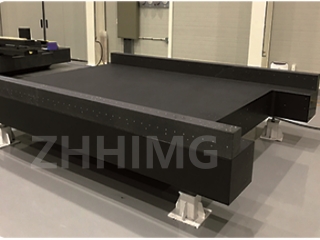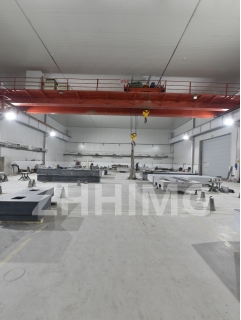In the high-precision processing scenarios of picosecond-level laser marking machines, the base, as the core supporting component of the equipment, its material selection directly determines the stability of the processing accuracy. Granite and cast iron are two common materials for base manufacturing. This article will conduct a comparison from aspects such as physical properties, the principle of precision attenuation, and practical application data, providing a scientific basis for equipment upgrading.
I. Material Property Differences: The Underlying Logic of Precision Performance
Granite is a natural igneous rock, formed by the close crystallization of minerals such as quartz and feldspar inside. It is characterized by a dense structure and high hardness. Its density is usually between 2.7 and 3.1g/cm³, and its coefficient of thermal expansion is extremely low, approximately (4-8) ×10⁻⁶/℃, which can effectively resist the influence of temperature changes on the accuracy of the equipment. In addition, the unique microstructure of granite endows it with excellent damping performance, enabling it to quickly absorb external vibration energy and reduce the interference of vibration on processing accuracy.
Cast iron, as a traditional industrial material, has a density of approximately 7.86g/cm³, relatively high compressive strength, but is hot
The expansion number (approximately 12×10⁻⁶/℃) is 1.5-3 times that of granite. Moreover, there are flake graphite structures inside cast iron. During long-term use, these structures may lead to stress concentration, affecting the stability of the material and subsequently causing a decline in precision.

Ii. Precision Attenuation Mechanism in Picosecond-level Machining
Picosecond-level laser processing has extremely high requirements for environmental stability. Any slight deformation of the base material will be magnified into the processing result. Temperature fluctuations, vibrations generated by equipment operation, fatigue under long-term load, etc., are all key factors leading to accuracy attenuation.
When the temperature changes, the size of granite changes slightly due to its low coefficient of thermal expansion. The relatively large thermal expansion coefficient of cast iron will cause the base to undergo deformation that is difficult to detect with the naked eye. This deformation will directly affect the stability of the laser optical path and cause the marking position to shift. In terms of vibration, the high damping characteristic of granite can attenuate 100Hz vibration within 0.12 seconds, while cast iron requires 0.9 seconds. Under high-frequency vibration conditions, the processing accuracy of equipment with cast iron bases is more prone to fluctuations.
Iii. Comparison of Precision Attenuation Data
According to the tests of professional institutions, during the continuous 8-hour picosecond laser marking operation, the attenuation of the XY-axis positioning accuracy of the equipment with a granite base is within ±0.5μm. The precision attenuation of the cast iron base equipment reaches ±3μm, with a significant difference. In a simulated environment with a temperature change of 5℃, the thermal deformation error of the granite base equipment is only + 0.8μm, while that of the cast iron base equipment is as high as + 12μm.
Furthermore, from the perspective of long-term use, the misjudgment rate of granite bases is only 0.03%, while the misjudgment rate of cast iron bases is as high as 0.5% due to structural stability issues. These data fully demonstrate that under the high-precision requirements of picosecond-level processing, the stability advantage of the granite base is significant.
Iv. Upgrade Suggestions and Practical Applications
For enterprises that pursue ultimate processing accuracy, upgrading the cast iron base to the granite base is an effective way to enhance the performance of the equipment. During the upgrade process, attention should be paid to the processing accuracy of the granite base to ensure that the surface flatness meets the design requirements. At the same time, in combination with auxiliary devices such as the air flotation vibration isolation system, the anti-vibration performance of the equipment can be further optimized.
At present, in industries such as semiconductor chip manufacturing and precision optical component processing, laser marking machines with granite bases have been widely adopted, effectively enhancing product yield and production efficiency. For instance, after a certain optical component manufacturer upgraded the cast iron base equipment, the product precision qualification rate increased from 82% to 97%, and the production efficiency was significantly enhanced.
In conclusion, in the base upgrade of picosecond-level laser marking machines, granite, with its outstanding thermal stability, high damping performance and long-term precision retention ability, has become an ideal choice superior to cast iron. Enterprises can reasonably select base materials based on their own processing requirements and budgets to achieve a comprehensive upgrade of equipment performance.
Post time: May-19-2025

